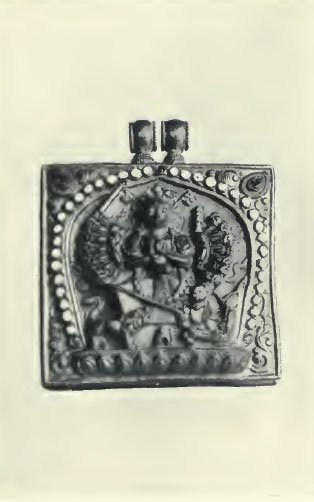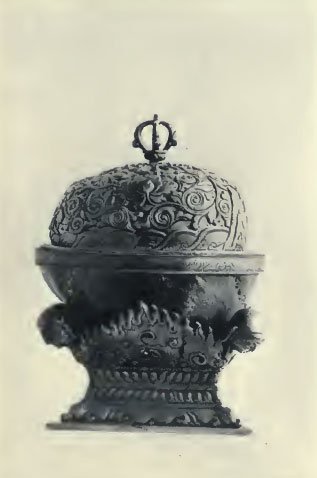The gods of northern Buddhism
their history, iconography and progressive evolution through the northern Buddhist countries
by Alice Getty | 1914 | 98,662 words
Indispensable reference for art historians, scholars of Eastern philosophy and religion. Wealth of detailed scholarly information on names, attributes, symbolism, pictorial representations of virtually every major and minor divinity in Mahayana pantheon, as worshipped in Nepal, Tibet, China, Korea, Mongolia, and Japan. 185 black-and-white illustrat...
Chapter XV - Historical Personages Deified
Table XV
I. Arhat (Lohan, Rakhan).
II. Nagarjuna.
III. Padmasambhava.
IV. Tson-k'a-pa.
V. Mil-ras-pa.
Arhat [1] (or Arhan, or Sthavira).
(T.) gnas'brtan (pro. netan), or netan cudug (the sixteen sthavira).
(M.) dain-i darughsan (the vanquisher of enemies), or batu-aqci (steady, constant, or fum).
(C.) Lo-han.
(J.) Rakhan.
An Arhat is one who has reached the end of the Eight-Fold Path, and is not only perfect himself, but can give perfection to others. Gautama Buddha, before making the Great Vow of the Bodhisattva, was, in one of his incarnations, the Arhat Sumedha.
In the Buddhist temples of Tibet, China, Japan, and Corea, along the east and west walls of the principal hall, are rows of figures usually seated. These are the Arhats, disciples of the Buddha, patrons and guardians of Buddhism, and may be either five hundred in number or in a group of sixteen. In China, however, as well as often in Tibet, one finds a group of eighteen Arhats. The reason for the addition of two Arhats to the traditional group of sixteen is not clear, for, according to Watters, [2] in the ancient Chinese literature, there is only question of sixteen Lo-han.
Besides these two groups of Arhats there are the four 'great Bhikshu' to whom the Buddha entrusted the propagation of Buddhism after his death. They are Mahakasyapa, Pindola (Manla), Kuntes-pan-t'an, and Rahula.
These men were to
'remain in existence and not experience Nirvana until the advent of Maitreya as Buddha'.
Two of these, Pindola and Rahula, are among the eighteen Lo-han.
The fifth Arhat is called Nakula in China, and is represented like Jambala with a mongoose under his arm (v. Kuvera). Some of the names of the Arhats vary in the different countries.
Nagarjuna
(T.) klu-ssgrub (the serpent saint).
(M.) naganjuna baksi (Nagarjuna, the teacher).
Mudra: dharmacakra (teaching).
Nagarjuna is usually called the 'founder' of the Mahay ana system; but it is claimed by some that he was only its principal expounder. The Japanese look upon Asvaghosha, the probable master of Nagarjuna, as the founder of the doctrine of the Great Vehicle. Others, still, believe that Nagarjuna founded the Madhyamika school and was the first to teach the Amitabha doctrine. It is thought that he lived in the beginning of the second century a. d., but the exact dates of his birth and death are still unknown.
He was born in Southern India, and his parents were of the Brahman caste. At his birth, according to an old Tibetan legend, it was predicted that he would only live seven days. In consideration of the acts of merit performed by his parents, the gods delayed his death until seven weeks, and then to seven months, and finally to seven years. Before the seven years were up, he was sent to the convent of Nalanda, where he learned to adore Amitayus, god of Long Life, and succeeded in so propitiating the god that he is said to have lived three hundred years on earth, ending his life only by cutting off his own head.
Nagarjuna was the greatest Buddhist philosopher and mastered all the sciences, and especially magic art. He is said to have acquired Siddhi, by which magic power he obtained the ' rainbow ' body (jahlus), and was thus able to become invisible at will and transport himself from one place to another by supernatural power.
The Tibetan Buddhists claim that Nagarjuna was the fourteenth of the twentyseven Patriarchs that propagated the Buddhist faith, beginning with the senior disciple of the Buddha, Kasyapa, and ending with Bodhidharma, who carried Buddhism into China in the sixth century A. D.
According to the Chinese and Japanese Buddhists, he was the third of the eight Patriarchs of the Yogacarya school, beginning with Vairocana and ending with the Japanese sage Kukai (Kobo Daishi). According to the Buddhist texts, Sakya-muni predicted the rebirth of his disciple Ananda under the name of 'Nagarjuna', founder of the Mahayana system. Nagarjuna is believed by the Shin-gon sect to have received the secret Yoga doctrine directly from the second Patriarch, Vajrasattva, whom he visited in his Iron Tower in Southern India.
Other Mahayana Buddhists (the Amitabha sects), however, claim that he received the treatise on which he expounded and developed the Mahayana school from the serpent-gods, the Nagas; and that the Naga king himself revealed to Nagarjuna the holy texts in the Dragon palace under the sea. They further claim that Gautama Buddha had given this treatise, the Prajnciparamitd, to the Nagas to guard until such a time as the world should become sufficiently enlightened to understand its transcendent wisdom; and that the Nagas, after converting Nagarjuna to Buddhism, handed over to him their precious Measure.
In the representations of Nagarjuna, who was deified and enrolled among the Northern Buddhist divinities, he has an aureole on which are seven snakes. If painted, the middle one is yellow and the others grey. He is represented like a Buddha with the ushnisha, urna, and long-lobed ears, and wears the monastic garments. He has no symbols, and his hands are in dharmacakra mudra. If painted, he is white.
Padmasambhava
(Lotus-born).
(T.) pad-ma hbjuh-gnas (lotus-born), or u-rgyan-pa (the crowned one).
(M.) padmasambhava.
Symbols: khatvanga (magic stick), vajra (thunderbolt), patra (begging-bowl).
In the middle of the eighth century A. D. the Tibetan king Thi-Sron Detsan sent to India inviting the learned guru Padmasambhava to come to Tibet. Padmasambhava was renowned for his knowledge of dharani (mystical sentences) and of their efficacious application, and was warmly welcomed. He remained fifty years in the country, founding monasteries and teaching the TantraYogacarya doctrine. He is said to have subdued all the malignant gods in Tibet, sparing only those that became converted to Buddhism and that promised to be defenders (Dharmapala) of the doctrine. Padmasambhava, in his turn, promised to enroll them in the Mahayana Pantheoa and to see that they were properly worshipped. He claimed to have received from the dakini the books from which he acquired his miraculous powers.
At the end of fifty years Padmasambhava disappeared miraculously, and is said to have entered the body of a Yaksha king, Me-wal, where he has reigned supreme ' over all the Yakshas up till the present day and in perpetual youth, is preaching the doctrine of Lamaism in a paradise which rivals that of Amitabha's western heaven of SukhavatI ' (Waddell, Lamaism).
Padmasambhava was deified and is still worshipped by the Northern Buddhists of Tibet. He is represented seated on a lotus asana with the legs locked, the right hand holding the vajra, and the left, lying in his lap, the patra. He holds his special symbol, the hhatvahga (which he is believed to have invented), pressed against his breast with the left arm. The vajra was also made popular in Tibet by Padmasambhava, who used it in casting spells and exorcising devils.
His garment is flowing, and, if painted, is red, as well as his peaked cap, which sometimes ends in a half vajra. The lappets over the ears are divided and turned back, thus resembling a lotus-flower, for Padmasambhava is believed to have been born from a red lotus-flower.
Besides the bronzes, one often finds Padmasambhava represented in the temple paintings of the Dharmapala. He is probably put in their company because he subdued them, and also because, according to the Mahayana traditions, there must always be one pacific deity among the ferocious gods. He is always placed at the top of the picture above them, and is sometimes accompanied by two disciples.
In China and Japan his worship is practically unknown.
Ts'on-k'a-pa (lit. 'Man from Ts'on-k'a').
(S.) Swmatikirti.
(T.) blo-bzan grags-pa (pro. lobsan dagha).
(M.) jonqaba.
Mudra: dharmacakra.
Symbols: khadga (sword), imstaka (book).
Ts'on-k'a-pa was born in Tibet, in the valley of Ts'on-k'a, in the middle of the fourteenth century, and it is said that the tree which overshadowed the house in which he was born has the imprint of a Buddha on its leaves.
Ts'on-k'a-pa, the Northern Buddhist reformer, founded the Ge -lug-pa sect, which he called the ' virtuous '. In spite of the severity of its rules and the practice of celibacy which it enforced, the Ge-lug-pa sect became very popular, quickly spreading over Tibet, and has remained the most important sect up to the present day.
They were called 'yellow bonnets' from the pointed yellow caps which they wore in opposition to the 'red bonnets' (Kar-gyu-pa), a sect founded over three centuries before, which allowed the priests marriage, besides many other liberties, and permitted the practice of sorcery.
Ts'on-k'a-pa, at his death, put the church under the protection of the god of Death, Yama (some say under Yamantaka), and repaired to the Tushita heaven, where he is believed to be sitting beside the future Buddha, Maitreya. He was canonized as an incarnation of Manjusri, and enrolled in the Northern Buddhist Pantheon.
Ts'on-k'a-pa is represented seated on either a kholbok or a lotus. He wears the yellow pointed cap with the long ear-lappets, and his hands are in dharmacakra mudra, holding the stems of lotus-flowers, which support, at each shoulder, the sword and book (Manjusri's symbols). His garment, if painted, is red.
He is generally represented in temple pictures with two of his disciples, while below is sometimes Yamantaka.
Mi-la-ras-pa
(T.) grub-pai dban-p'yug Mi-la (the mighty saint, Mi-la).
Mi-la-ras-pa, mendicant monk and poet, lived in the beginning of the twelfth century A. D., and spent his life wandering through Tibet performing miracles, converting the nomadic people to Buddhism, and writing his 100,000 songs, which have never, as yet, been translated into English. [3]
He was deified and enrolled in the Northern Buddhist Pantheon, but does not figure in the Pantheon of the Tschantscha Hutuktu.
Mi-la-ras-pa is represented in the bronzes seated on a gazelle-skin on a lotus usana. He has short, curly hair, the urna, is dressed in monastic garments, and always holds his right hand with the fingers extended and the palm turned outwards behind his right ear, as if he were listening to the 'echoes of nature', to use his own words. His left hand holds a begging-bowl (PL lx, fig. a).
| PLATE LXII | ||
 |
 |
|
| a. Citipati | b. Dharmapala | |
 |
 |
|
| c. Skull-cup | d. Dai-nichi Nyorai (Vairocana) | |
| PLATE LXIII | ||||
 |
 |
 |
||
| a. Vairocana | b. Padmapani | c. Amitabha | ||
 |
||||
| d. Gautama Buddha | ||||
 |
 |
 |
||
| e. Tara | f. Mahakala | g. Manjusri | ||
| PLATE LXIV |
 |
| Kwan-yin |
Footnotes and references:
[1]:
Arhat, lit. 'fit', 'worthy'.
[2]:
The Eighteen Lohan of the Chinese Buddhist Temples.
[3]:
There is a fragment translated into French, Grunwedel, Mythologie du Bouddhisme, p. 62.
